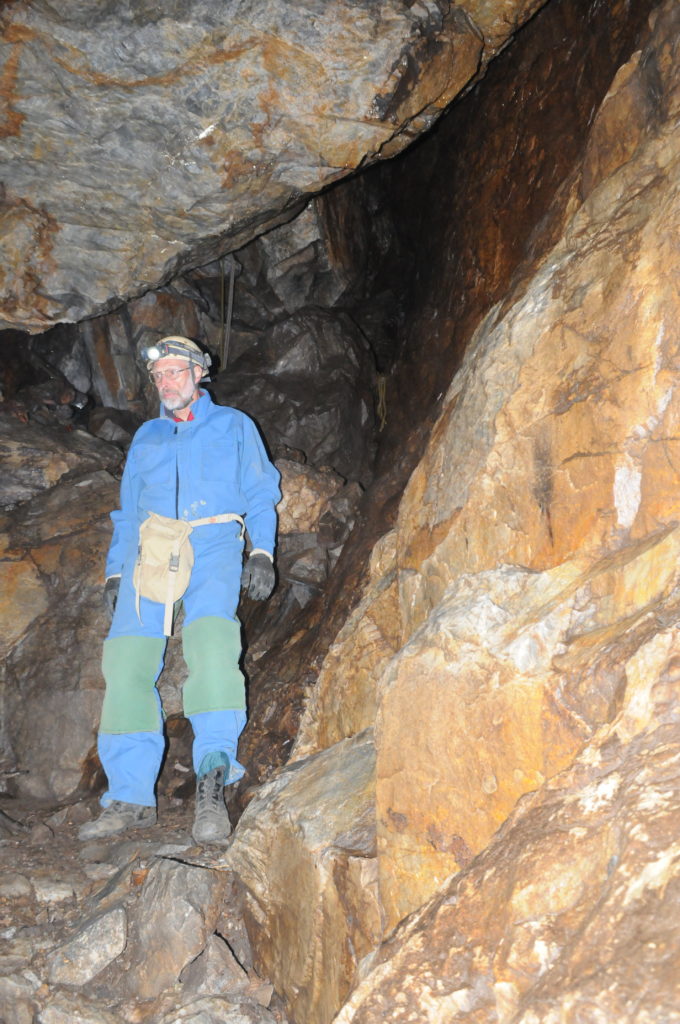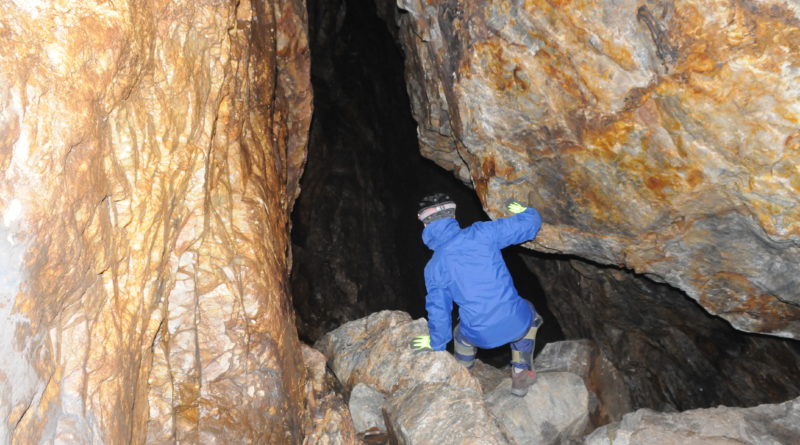Into the Darkness
Inside Vermont’s Ice Cave with Rodrick Pingree.
Story and photos by Angelo Lynn
Dropping into the darkness of the cave, I had misgivings. The rock was damp and cold, the air a chilly 45 degrees (20 degrees colder than the shady gulch outside), and the first moves across a log pole and down a crude wood ladder led us deep into a dark pit. The obvious route led over a steep ledge, but ropes would be required. Instead, we were told to angle right, where we climbed down another 10-foot chimney into a large cavernous room. Just 10 minutes into the cave, we were in blackness.
Our guide, Rodrick Pingree, had us turn off our headlamps and let our eyes adjust. All was black for that first minute, then above us 40 feet and off to our right a faint tinge of light reflected off the cave wall.
“It’s why we always carry three sources of light,” Pingree said of the number one rule of caving. He told us of a rescue a few years ago in which two spelunkers had been exploring Nickwackett Cave in Chittenden for several hours and lost all source of light while crawling in a narrow passage. The two cavers continued until they hit a wall then froze, afraid to move one way or the other with no clue which way was out. They stayed there for two days until a rescue team arrived.

My colleague Evan Johnson and I double-checked our three headlamps as Pingree pursued another smaller hole, this one leading back 100 more feet. Then we wormed our way through the talus-strewn tunnels into another, darker chamber.
We turned off our headlamps again and proved a caver’s saying: you’ll never see anything darker than the pitch black of a cave. Moving in such darkness is almost impossible with uneven footing, slick rock, chunks of talus and the occasional pools of water. It’s useless to grope in the darkness for openings that may lead to nowhere, or perhaps into an uncharted tunnel. It’s one of the real dangers of caving: being caught hundreds of feet underground and not being able to retrace your path before exhausting your resources.
But what surprised us more than the darkness was how easy it was to get lost in the tunnels even with your headlamps on, even in a beginner’s cave that is fairly safe as caves go.
We continued climbing up a narrow, twisty chimney. The sides were talus jumbled loosely together with mega-tons of weight holding rocks precariously in place. Then, we maneuvered along a narrow horizontal slit by bridging our backs against one wall and our feet against the other. It was only by contorting our bodies that we made it through a tight, 36-inch opening into a narrow crawl space that led to another upper chamber about 10 feet by 8 feet.
In the larger chamber light glinted off the icy sides of the rock. Pingree, who is one of the founding members of the Vermont Cavers Association, explained that the cave we were exploring had one unique feature uncommon to most other caves: it’s icy from winter though mid-summer. Wind blows through the cave passages keeping it cold, and in summer it lies in a narrow talus gulch that gets little sunshine. That allows the cave to be colder than most, which usually stay in the 45-47 degree range year-around.
We had been in the cave about an hour and gone a horizontal distance of about 100 feet, when Pingree suggested we find our way out. We started back but soon it was difficult to remember if we had gone up or down, left or right through passages that started to look the same. And just how had we slithered and squirmed our way through that one contorted passage? The second most important rule of caving: never go into a cave you don’t know or without someone who does, always go with at least four people (if possible) and always tell someone at home where you’re going.
An original founder of the Vermont Cave Association Rescue team, Pingree also told us of another rescue a couple years ago in the Horse Farm Road Cave in Weybridge. A few inexperienced guys had found the cave entrance. Without ropes or proper gear, they attempted to downclimb the first 40 feet and one of the men slipped, falling a good distance to the floor of the pit and injured his leg. When the rescue team reached the man, they realized they would have to put him in a stretcher to haul him out, but the slit in the cave wasn’t large enough to get the stretcher with him in it out, so they spent hours chiseling off a flake of the cavern wall to create a big enough space to get him out — 16 hours later.
“It’s not like climbing outside on a rock face,” Rodrick said, “where you can usually reach someone who’s in trouble. That’s why we stress safety, and that begins with knowing the cave before you set foot inside, and if you don’t then go with someone who does.”
Rodrick has been the president of the group in its early years after its establishment in 1992, and again years later, and has helped discover, explore and map many of the 20 or so known caves in Vermont and throughout the region. Access to the caves and precise location are not publicized to ensure those who enter the caves go with someone who has been there before. Most VCA members have access to hand-drawn maps that have been carefully plotted throughout the years by cavers.
Pingree has helped map and explore 13 caves in Vermont. For two years in 1998-99, he explored and charted the Perseverance Cave, where he found three caverns with drops of 44, 77 and 89 feet. The cave has several pools to swim (requiring a wetsuit) and long stretches of crawls with several pinches—places that get less than 24-inches high and just over shoulder width wide what most of us would consider too tight for comfort.
Pingree also helped explore and map the Aeolus Cave, also known as the Dorset Bat Cave, in 2000. It was thought to originally be about 500 feet, but later Pingree and others found narrow passageways that eventually led to its 3,000-foot length — one of the largest in Vermont.
Though it is currently closed because of White Nosed Bat Syndrome, Pingree recalled taking a state biologist into the Dorset cave not long after its discovery and counting an estimated 30,000 bats inside some of the bigger rooms. Years later, after the white-nosed bat syndrome hit the region, he and the state biologist returned to find almost all of the bats wiped out.
“The stench in the cave was overwhelming,” Pingree said, recalling crawling through passages on his hands and knees, dead and dying bats crunching under him. “Some of the bats were still moving their wings, and at times the passageways were just thick with them…I haven’t gone back since.”
Cavers also have to wary of spreading the disease from cave to cave from their clothing. Washing garments after caving, and not going into caves in which bats hibernate during winter months, are precautions that should be strictly followed to avoid further harm to bat populations.
Many = caves have been closed to protect bats, including the Brandon Silver Mines, six caves within the Purgatory Karst region, Nickwackett and Chaffee Mountain caves in Chittenden, and Plymouth Caves, next to where Pingree grew up and began first caving when he was four.
With all the rules and regulations, cave closures to bat disease and the discomfort of the sport itself, why do it? Good question. Most don’t. But the sport does offer some other-worldly sights.
We saw just enough to know that it can be magical underground, and if you don’t mind the bats and spiders, aren’t claustrophobic and are flexible enough (and willing) to squeeze through 19-inch spaces, there are underground waterfalls to see, pools to swim in, beautiful marbled stone walls to witness and the wonders of the underworld to explore.
It’s cool, exciting and adventurous, but just creepy enough to keep most of us on the lighter side of darkness.
Getting Into Caving
The Vermont Caving Association meets the third Sunday of the month from April to October at the Rutland Regional Ambulance offices, and sends out an e-newsletter every other month announcing upcoming activities, including cave explorations. www.vermontcavers.org. In addition to always going with an experience caver and a group of three or more,Pingree notes a few other do’s and don’ts of caving:
- don’t deface cave walls with markings;
- don’t have a fire in caverns (it can use precious oxygen in a tight spot, and leaves a mess);
- pack out what you pack in;
- never pee in a cave (the stink doesn’t easily dissipate, so pee in a plastic bottle and haul it out);
- be respectful of property owners and never trespass without first gaining permission.
The VCA has spent years developing good relations with property owners, something that can be undone with a single bad experience with cavers who don’t know the proper protocol.
Photo Caption: The Ice Cave got its name since it is unusually cold and can have ice in it as late as July. Here, Evan Johnson prepares to descend into the main chamber of the cave. Photo by Angelo Lynn.

